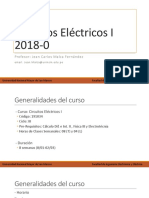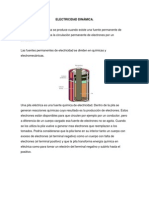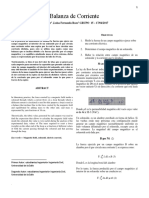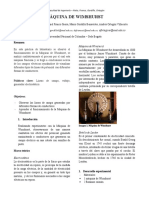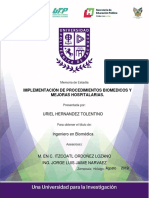Informe Practica de Laboratorio Ley de Ohm
Informe Practica de Laboratorio Ley de Ohm
Cargado por
Cristhian Felipe Luengas MoraCopyright:
Formatos disponibles
Informe Practica de Laboratorio Ley de Ohm
Informe Practica de Laboratorio Ley de Ohm
Cargado por
Cristhian Felipe Luengas MoraTítulo original
Derechos de autor
Formatos disponibles
Compartir este documento
Compartir o incrustar documentos
¿Le pareció útil este documento?
¿Este contenido es inapropiado?
Copyright:
Formatos disponibles
Informe Practica de Laboratorio Ley de Ohm
Informe Practica de Laboratorio Ley de Ohm
Cargado por
Cristhian Felipe Luengas MoraCopyright:
Formatos disponibles
lOMoARcPSD|7718672
INFORME PRÁCTICA DE LABORATORIO LEY DE OHM
Física II (Universidad de La Salle Colombia)
StuDocu is not sponsored or endorsed by any college or university
Downloaded by Cristhian Felipe Luengas Mora (cristhian.luengas01@correo.usa.edu.co)
lOMoARcPSD|7718672
PRACTICA4: Ley de Ohm
Natalia López Dimaté⁰
RESUMEN:
En ésta práctica titulada ‘’Ley de Ohm’’, se logró comprobar de forma
experimental la ley anteriormente mencionada. A través del uso del código
de colores de resistencias se pudo determinar el valor del resistor, y se
observó el funcionamiento de los resistores en un circuito al estar
conectados en serie. Para la realización de ésta práctica, fue necesario
realizar mediciones de corriente y voltaje en conexiones en serie de una
resistencia fija y una variable donde en ésta el valor del resistor era
desconocido y de inmediato se procedía a ser conectado a un amperímetro.
Los datos obtenidos, se usaron para realizar una gráfica de Voltaje en
función de Corriente, en donde el valor de la resistencia desconocida estaba
dado por la pendiente de dicha gráfica.
.
Palabras clave: Voltaje, corriente, circuito en serie, Ley de Ohm, Voltímetro,
Amperímetro.
ABSTRACT:
In this practice entitled ' ' Ohm's Law '' it was achieved experimentally verify the above
law. Through the use of color coding resistors could be determined resistance value ,
and the operation of the resistors was observed in a circuit to be connected in series . To
carry out this practice , it was necessary measurements of current and voltage in series
connection of a fixed and a variable resistance which in this resistor value was unknown
and immediately proceeded to be connected to an ammeter . The data obtained were
used to make a graph of voltage as a function of current, where the value of the
unknown resistance was given by the slope of the graph.
Key words: Voltage, current, series circuit , Ohm's Law, voltmeter , ammeter.
1. Introducción
Corriente eléctrica fluye a través de esta superficie. Si Δ es
la cantidad de carga que pasa a través de
Siempre que se desplazan cargas del
ésta área en un intervalo de tiempo Δ , la
mismo signo, se dice que existe una
corriente, es igual al cociente de la carga
corriente. Con objeto de definir la
entre el intervalo de tiempo:
corriente con más precisión, supóngase
que las cargas se desplazan en sentido
perpendicular a una superficie de área A.
La corriente es la razón a la que la carga
Fórmula 1.
⁰ Grupo 02, Ingeniería ambiental y sanitaria, Universidad de La Salle.
Downloaded by Cristhian Felipe Luengas Mora (cristhian.luengas01@correo.usa.edu.co)
lOMoARcPSD|7718672
sección transversal en un intervalo de
tiempo de 1 s.
La unidad del SI de corriente es el
ampere (A): Cuando fluyen cargas a través de una
superficie, pueden ser positivas,
negativas o ambas cosas. Por
convención, se asigna a la corriente la
misma dirección que tiene el flujo de
Así pues, 1 A de corriente equivale a 1 C carga positiva.
de carga que pasa a través del área de
La corriente convencional siempre va de
un potencial alto a un potencial bajo.
La corriente continua es un movimiento en un circuito eléctrico. El símbolo de
de electrones, cuando los electrones resistor en los diagramas de circuitos es
circulas por un conductor, encuentran una línea en zigzag.
una cierta dificultad al moverse. A esta
dificultad se le llama resistencia
eléctrica.
Resistencia y Ley de Ohm
Cuando se aplica un voltaje (diferencia
de potencial) entre los extremos de un
conductor metálico, se encuentra que la Figura 1. Resistencias
corriente en el conductor es Código de colores de resistencias
proporcional al voltaje aplicado; es
decir, I∝ ΔV. Si la proporcionalidad es La mayor parte de los resistores
exacta, podemos escribir ΔV=IR , lineales, es decir aquellos que se
donde la constante de proporcionalidad someten a la ley de Ohm, normalmente
R recibe el nombre de resistencia del se codifican con colores para dar el
conductor. De hecho, definimos esta valor de su resistencia en ohmios.
resistencia como la razón del voltaje
entre los extremos del conductor a la
corriente que el mismo transporta:
Fórmula 2.
La resistencia tiene unidades SI de volts
por ampere, llamados ohms (Ω). Por
tanto si una diferencia de potencial de 1
V entre los extremos de un conductor
produce una corriente de 1 A, la
resistencia del conductor es de 1 Ω.
Figura 2. Código de colores de resistencias
Un resistor es un conductor que
proporciona una resistencia específica
⁰ Grupo 02, Ingeniería ambiental y sanitaria, Universidad de La Salle.
Downloaded by Cristhian Felipe Luengas Mora (cristhian.luengas01@correo.usa.edu.co)
lOMoARcPSD|7718672
En esta práctica se quiere determinar el
valor de una resistencia desconocida
mediante la utilización de la ley de
Ohm, que establece que existe relación
lineal entre la tensión aplicada entre los
extremos de la resistencia y la corriente
eléctrica que la atraviesa. La constante
relaciona ambas magnitudes es
precisamente el valor de la resistencia
eléctrica, de forma que se cumple:
Los circuitos en serie son aquellos
V = R*I circuitos donde la energía eléctrica
Dónde: solamente dispone de un camino, lo
cual hace que no interesen demasiado lo
I = Intensidad en amperios (A) que se encuentra en el medio y los
V= Diferencia de potencial en elementos que la componen no pueden
voltios (V) ser independientes.
R= Resistencia en ohmios (Ω)
O sea aquí solamente existe un único
La ley de Ohm tiene algunas camino desde la fuente de corriente
limitaciones como: hasta el final del circuito (que es la
Al utilizarse esta ley debe misma fuente). Este mecanismo hace
recordarse que la resistencia que la energía fluya por todo lo largo
cambia con la temperatura pues del circuito creado de manera tal que no
todos los materiales se calientan hay ni independencia ni distinción en
por el paso de corriente los diferentes lugares de este.
Algunas aleaciones conducen Las características de los circuitos en
mejor las cargas en una serie son fáciles de diferencias,
dirección que otra comenzando con que la suma de las
Se puede aplicar a los metales caídas de la tensión que ocurren dentro
pero no al carbón o a los del circuito son iguales a toda la tensión
materiales utilizados en los que se aplica. Además, la intensidad de
transistores la corriente es la misma en todos los
Circuitos en serie lugares, es decir en cualquier punto de
La distribución usual de resistencias en la distribución.
serio, determina que la corriente en este Queda por mencionar que la
tipo de conexión esta igual en todos los equivalencia de la resistencia del
puntos y que la suma de los voltajes circuito es el resultado de la suma de
parciales son el voltaje total todas las resistencias, el resultado está
I = V/RTOTALRTOTAL = R1 + R2 + R3 + dado por las resistencias compuestas.
…… + Rn Lo que este tipo de circuitos tiene de
VTOTAL = VR1 + VR2 + VR3 + ….. + VRn desventaja es que si uno de los
componentes se rompe o se saca, todo el
circuito deja de funcionar por eso hoy
en día los circuitos en serie no son los
⁰ Grupo 02, Ingeniería ambiental y sanitaria, Universidad de La Salle.
Downloaded by Cristhian Felipe Luengas Mora (cristhian.luengas01@correo.usa.edu.co)
lOMoARcPSD|7718672
favoritos a la hora de ser elegidos y se
opta mayoritariamente por circuitos
mixtos, formados entre los circuitos
paralelos y los circuitos en serie.
2. Objetivos:
Reconocer y deducir experimentalmente
la ley de Ohm.
Figura 4
3. Materiales y montaje:
En la práctica de laboratorio se
utilizaron los materiales a continuación
mencionados:
Voltímetro
Amperímetro
Cables positivos y negativos
Resistencias
Figura 5
Figura 3
Figura 6
⁰ Grupo 02, Ingeniería ambiental y sanitaria, Universidad de La Salle.
Downloaded by Cristhian Felipe Luengas Mora (cristhian.luengas01@correo.usa.edu.co)
lOMoARcPSD|7718672
Figuras 1,2,3,4,5 y 6 (Materiales cada valor de la corriente y posterior a
empleados en la práctica de esto, se anotaron los datos en la tabla
laboratorio) Voltaje (V) vs Corriente (I). Con base
en la información obtenida a través de
las tablas de datos, se identificó la
relación entre voltaje y corriente.
4. Resultados
Tabla No.1 (Voltaje e intensidad
hallados en la práctica con una fuente
de 10 V y 5000 )
V (Volt) i (A)
2,9 0,6
Y, se realizaron los siguientes montajes:
3,9 0,8
Se construyó un circuito que permitiera 4,6 0,9
variar el voltaje aplicado en una 5,4 1,1
resistencia de valor fijo, luego se 7,6 1,5
conectó el voltímetro y el amperímetro 8,2 1,6
para medir el voltaje y corriente 9,3 1,9
respectivamente en la resistencia. Se 10 2
verificó que el circuito estuviera 13,4 2,7
debidamente conectado como se
14,9 3
observa en la figura 7.
Teniendo en cuenta los datos
anteriormente presentados, se hizo una
regresión lineal, y estos fueron los
resultados arrojados por la calculadora:
Dónde:
A= Punto de corte A= 0,0135
B=Resistencia B= 4972 Ω
Figura 7. (Primer montaje).
r= coeficiente de la relación
r=0,9995243634
Para la medida de voltaje y corriente en
una resistencia, se procedió variando el
voltaje aplicado a la resistencia para Error% = 5000 - 4972 x100 = 0,6%
⁰ Grupo 02, Ingeniería ambiental y sanitaria, Universidad de La Salle.
Downloaded by Cristhian Felipe Luengas Mora (cristhian.luengas01@correo.usa.edu.co)
lOMoARcPSD|7718672
5000 Teniendo en cuenta los datos
anteriormente presentados, se hizo una
regresión lineal, y estos fueron los
resultados arrojados por la calculadora:
Donde:
A= Punto de corte A= 0,2288
Tabla No. 2(Segunda toma de voltaje B=Resistencia B= 6718 Ω
e intensidad con fuente de voltaje de r= coeficiente de la relación,
15 v y una resistencia fija de 6700 ) r=0,9984752706
¿ 6700 Ω−6718 Ω∨ ¿ x 100=0,268%
6700 Ω
%Error=¿
5. Análisis de resultados:
Voltaje Vs Corriente
16
14
12
10
Voltaje (V)
8
6
4
2
0
0 0.5 1 1.5 2 2.5 3 3.5
Corriente (I)
Gráfica 1 (Voltaje Vs Corriente) Tabla 1.
⁰ Grupo 02, Ingeniería ambiental y sanitaria, Universidad de La Salle.
Downloaded by Cristhian Felipe Luengas Mora (cristhian.luengas01@correo.usa.edu.co)
lOMoARcPSD|7718672
En la gráfica 1, se puede observar el comportamiento del voltaje vs corriente, resaltando
que tiene un comportamiento lineal de la forma Y=MX+B, donde el voltaje es igual a la
resistencia por la corriente más el punto de corte. En esta situación, V= RI+ 0,0135,
donde es posible reemplazar ‘’I’’ por un valor de corriente cualquiera.
Voltaje Vs Corriente
16
14
12
Voltaje (V)
10
8
6
4
2
0
0 0 0 0 0 0 0 0 0
Corriente (I)
Gráfica 2(Voltaje Vs Corriente) Tabla 2.
En la gráfica 2, se puede observar el comportamiento del voltaje vs corriente, resaltando
que tiene un comportamiento lineal de la forma Y=MX+B, donde y=v, x=I y B= punto
de corte (V=voltaje, R= resistencia, I= corriente), concluyendo con la información
anteriormente suministrada se obtiene que V=RI+B.
En general, la práctica no fue mala, se obtuvieron resultados con pequeños márgenes de
error y se estableció la relación entre voltaje y corriente.
6. Conclusiones:
Se logró comprobar que la diferencia de potencial aplicada a los extremos de
un conductor es directamente proporcional a la corriente que pasa a través de
él como dicta la ley de Ohm.
Se logró identificar que el voltaje es proporcional a la corriente, de acuerdo
con la gráfica se obtuvo una recta con pendiente positiva entre V e I teniendo
en cuenta que R es el valor de dicha pendiente.
7. Cibergrafía:
http://www.asifunciona.com/electrotecnia/ke_ley_ohm/ke_ley_ohm_1.htm
⁰ Grupo 02, Ingeniería ambiental y sanitaria, Universidad de La Salle.
Downloaded by Cristhian Felipe Luengas Mora (cristhian.luengas01@correo.usa.edu.co)
lOMoARcPSD|7718672
http://www.profesorenlinea.cl/fisica/Electricidad_ley_Ohm.html
http://dieumsnh.qfb.umich.mx/electro/ley%20de%20ohm.htm
http://unicrom.com/Tut_leyohm.asp
⁰ Grupo 02, Ingeniería ambiental y sanitaria, Universidad de La Salle.
Downloaded by Cristhian Felipe Luengas Mora (cristhian.luengas01@correo.usa.edu.co)
También podría gustarte
- Ejercicios Anaya 3º Matematicas PDFDocumento72 páginasEjercicios Anaya 3º Matematicas PDFpaco ces100% (11)
- 04 Laboratorio de KirchhoffDocumento4 páginas04 Laboratorio de KirchhoffJaime GonzálezAún no hay calificaciones
- Trabajo ResistenciaDocumento4 páginasTrabajo ResistenciaEdison Boada50% (2)
- 3-Resistencia Interna de Un Amperímetro y de Un VoltímetroDocumento3 páginas3-Resistencia Interna de Un Amperímetro y de Un VoltímetroAnonymous vcgqFTyQAún no hay calificaciones
- Leyes de KirchhoffDocumento14 páginasLeyes de KirchhoffJose Mariños50% (2)
- Informe Previo #4 Taller de ElectricidadDocumento7 páginasInforme Previo #4 Taller de ElectricidadERICK ADONIS ANAYA FLORESAún no hay calificaciones
- Informe Previo Ley de OhmDocumento7 páginasInforme Previo Ley de OhmAldo0% (1)
- Práctica 0 Señales Eléctricas, Valor Promedio (V) y Valor Medio Cuadrático (V)Documento8 páginasPráctica 0 Señales Eléctricas, Valor Promedio (V) y Valor Medio Cuadrático (V)vivian yael higareda torresAún no hay calificaciones
- Informe RelésDocumento6 páginasInforme RelésManuel AlejandroAún no hay calificaciones
- Practica 1 Laboratorio de MedicionesDocumento7 páginasPractica 1 Laboratorio de MedicionesJorge ValenzuelaAún no hay calificaciones
- Circuitos Eléctricos I 2018 - 0Documento10 páginasCircuitos Eléctricos I 2018 - 0DanielAún no hay calificaciones
- Lab 3 PDFDocumento19 páginasLab 3 PDFDaniel CedeñoAún no hay calificaciones
- Magnitud Física Símbolo Unidad SIDocumento2 páginasMagnitud Física Símbolo Unidad SIBrandonRivasGiraldoAún no hay calificaciones
- Mapa MentalDocumento2 páginasMapa Mentaljulii alvarezAún no hay calificaciones
- Informe Nº1 Electromagnetismo.Documento24 páginasInforme Nº1 Electromagnetismo.Pedro Enrique Tuanama Quiroz100% (1)
- Electricidad DinámicaDocumento3 páginasElectricidad DinámicaCésar Fidel CruzAún no hay calificaciones
- Diapositivas Hidrostatica e Hidrodinamica.Documento37 páginasDiapositivas Hidrostatica e Hidrodinamica.Vivi EspiAún no hay calificaciones
- Tarea 3Documento2 páginasTarea 3fer soteroAún no hay calificaciones
- Experimento 03 Campo ElectricoDocumento8 páginasExperimento 03 Campo Electricojesús danielAún no hay calificaciones
- EJEMPLO DE INFORME - FisicaDocumento5 páginasEJEMPLO DE INFORME - Fisicaandres portillo100% (1)
- Laboratorio 01 Seguridad Eléctrica y Primeros AuxiliosDocumento3 páginasLaboratorio 01 Seguridad Eléctrica y Primeros AuxiliosVICENTE ALEXANDER CONDORI HUILLCAAún no hay calificaciones
- Previo 2 Fuentes de Alimentación de Corriente ContinuaDocumento5 páginasPrevio 2 Fuentes de Alimentación de Corriente ContinuaAnthony HuacachiAún no hay calificaciones
- LABORATORIO Balanza CorrienteDocumento4 páginasLABORATORIO Balanza CorrienteDiego ArdilaAún no hay calificaciones
- Informe Fisica Ley de OhmDocumento14 páginasInforme Fisica Ley de OhmDarnell GonzalezAún no hay calificaciones
- Informe Previo 2 Electrotecnia UnmsmDocumento11 páginasInforme Previo 2 Electrotecnia UnmsmNaki Jannet Dejo VicenteAún no hay calificaciones
- Osciloscopio y Generador de FuncionesDocumento8 páginasOsciloscopio y Generador de FuncionesAnonymous WcsXVzT3Aún no hay calificaciones
- Practica 3 OptoelectronicaDocumento10 páginasPractica 3 OptoelectronicaWendii Orozco PaduaAún no hay calificaciones
- Lab 8 ElectroDocumento9 páginasLab 8 ElectroANDREY GUERREROAún no hay calificaciones
- Apuntes de Física II Toda La MateriaDocumento26 páginasApuntes de Física II Toda La MateriaAnonymous PQIRfC50% (2)
- Laboratorio Ohm UfpsDocumento9 páginasLaboratorio Ohm UfpsYuriPeñaranda100% (2)
- Informe Final 2 ElectrotecniaDocumento11 páginasInforme Final 2 ElectrotecniaJeffry Calixto JaraAún no hay calificaciones
- Electrotecnia Experiencia 8Documento4 páginasElectrotecnia Experiencia 8Romario Carhuaricra DuranAún no hay calificaciones
- Corrientes Variables en El TiempoDocumento6 páginasCorrientes Variables en El TiempomanuejuanAún no hay calificaciones
- 6 Circuitos en Serie y ParaleloDocumento8 páginas6 Circuitos en Serie y ParaleloBryan André BMAún no hay calificaciones
- Lab Estrella-TrianguloDocumento4 páginasLab Estrella-Triangulojuan sebastian herrera vallejoAún no hay calificaciones
- Maquina de WimshurstDocumento3 páginasMaquina de WimshurstJuan Daniel CHAún no hay calificaciones
- Informe Practica 5 Carga y Deacarga de Un Capacitor NuevoDocumento10 páginasInforme Practica 5 Carga y Deacarga de Un Capacitor NuevoLeo Donado100% (1)
- Informe 1 Lab ElectronicosDocumento27 páginasInforme 1 Lab Electronicosgustavounac2018Aún no hay calificaciones
- GUÍA PRÁCTICA 2 Electronica AplicadaDocumento11 páginasGUÍA PRÁCTICA 2 Electronica AplicadaDavid LopezAún no hay calificaciones
- Laboratorio 2 Ley de OhmDocumento8 páginasLaboratorio 2 Ley de OhmOscar Andres Salamanca100% (1)
- P1 Introducción A Simulink 2010 - 11newDocumento16 páginasP1 Introducción A Simulink 2010 - 11newKasaLDAún no hay calificaciones
- Final 9Documento15 páginasFinal 9GuimarAún no hay calificaciones
- Ejemplificación de La Relación Entre La Biotecnología y La Física, A Través de La Ecuación de Michaelis-Menten.Documento15 páginasEjemplificación de La Relación Entre La Biotecnología y La Física, A Través de La Ecuación de Michaelis-Menten.Dental Solution JVMTAún no hay calificaciones
- Lab, Aparatos de MedicionDocumento9 páginasLab, Aparatos de MedicionDavid MeloAún no hay calificaciones
- Cuestionario Fisica 3: Campo ElectricoDocumento2 páginasCuestionario Fisica 3: Campo ElectricoHector100% (1)
- Informe Final 4 Laboratorio de ElectrotecniaDocumento8 páginasInforme Final 4 Laboratorio de ElectrotecniaJhonatan Juño GarciaAún no hay calificaciones
- Circuitos Paralelo LaboratorioDocumento9 páginasCircuitos Paralelo LaboratorioJorge SánchezAún no hay calificaciones
- Bobina ExploradoraDocumento8 páginasBobina ExploradoraEduar Andres Orozco CardenasAún no hay calificaciones
- Vector UnitarioDocumento27 páginasVector UnitarioEdison QuillayAún no hay calificaciones
- Compuerta XNORDocumento3 páginasCompuerta XNORAlexis SanchezAún no hay calificaciones
- Laboratorio 5Documento5 páginasLaboratorio 5Anonymous kprfdlAún no hay calificaciones
- Informe Efecto HallDocumento9 páginasInforme Efecto HallAnthony Saavedra GarciaAún no hay calificaciones
- Informe Laboratorio 2Documento6 páginasInforme Laboratorio 2Jhysseth GarcesAún no hay calificaciones
- BjlasdbjsdaDocumento23 páginasBjlasdbjsdaJose Anthony Castillo AlvaronAún no hay calificaciones
- AUTOINDUCTANCIADocumento5 páginasAUTOINDUCTANCIAaurelioAún no hay calificaciones
- 08-Práctica de Laboratorio Circuito Serie, Paralelo y MixtoDocumento4 páginas08-Práctica de Laboratorio Circuito Serie, Paralelo y MixtoduvierAún no hay calificaciones
- Circuitos de Corriente Alterna RCLDocumento24 páginasCircuitos de Corriente Alterna RCLStephany Daneri Beltran71% (7)
- Laboratorio Amplificador DiferencialDocumento17 páginasLaboratorio Amplificador DiferencialMiguel Angel SastoqueAún no hay calificaciones
- Final 1Documento7 páginasFinal 1davidAún no hay calificaciones
- Experiencia No 7. Resistividad y Ley de OHMDocumento9 páginasExperiencia No 7. Resistividad y Ley de OHMLiseth ZartoAún no hay calificaciones
- Experiencias sobre circuitos eléctricos en serie operados por corriente directaDe EverandExperiencias sobre circuitos eléctricos en serie operados por corriente directaAún no hay calificaciones
- Tipos de CuadrilaterosDocumento7 páginasTipos de CuadrilaterosCristhian Felipe Luengas MoraAún no hay calificaciones
- Contenido Multivariable 2021-1Documento4 páginasContenido Multivariable 2021-1Cristhian Felipe Luengas MoraAún no hay calificaciones
- CuadrilaterosDocumento5 páginasCuadrilaterosCristhian Felipe Luengas MoraAún no hay calificaciones
- Taller ExcedentesDocumento3 páginasTaller ExcedentesCristhian Felipe Luengas MoraAún no hay calificaciones
- PARCIAL DE EQUIVALENCIAS CorregidoDocumento12 páginasPARCIAL DE EQUIVALENCIAS CorregidoCristhian Felipe Luengas Mora0% (1)
- DerivadasDocumento5 páginasDerivadasCristhian Felipe Luengas MoraAún no hay calificaciones
- Prueba EvaDocumento1 páginaPrueba EvaCristhian Felipe Luengas MoraAún no hay calificaciones
- Taller de Algebra LinealDocumento3 páginasTaller de Algebra LinealCristhian Felipe Luengas MoraAún no hay calificaciones
- Ucn TaquimetriaDocumento4 páginasUcn TaquimetriaCristhian Felipe Luengas MoraAún no hay calificaciones
- Ind BCRDocumento24 páginasInd BCRCristhian Felipe Luengas MoraAún no hay calificaciones
- ENSAYO Movimiento 68Documento5 páginasENSAYO Movimiento 68manuel arturoAún no hay calificaciones
- Memoria de EstadiaDocumento72 páginasMemoria de EstadiaJonathan Zapata MontielAún no hay calificaciones
- Bases de Competencia Torneo Fútbol Macho LibreDocumento10 páginasBases de Competencia Torneo Fútbol Macho LibreMario duran100% (1)
- Ebook Marketing Farmacias.Documento31 páginasEbook Marketing Farmacias.siilviiniitaaciintiiaAún no hay calificaciones
- Meta 4.1 - Martinez - Covarrubias - Vazquez - OrtegaDocumento2 páginasMeta 4.1 - Martinez - Covarrubias - Vazquez - Ortegamartinez.ehinnerAún no hay calificaciones
- PD 6 Adl 1 Heine El Doctor Saul Ascher CL - CG BBDocumento6 páginasPD 6 Adl 1 Heine El Doctor Saul Ascher CL - CG BBnatalyAún no hay calificaciones
- Análisis de Género y Cambio Institucional en El Mundo Académico: Evaluación de La Utilidad de Los Enfoques Institucionalistas FeministasDocumento32 páginasAnálisis de Género y Cambio Institucional en El Mundo Académico: Evaluación de La Utilidad de Los Enfoques Institucionalistas FeministasCecilia ArrarteAún no hay calificaciones
- Ficha Tecnica, Protocolos de Intervencion 7-8Documento68 páginasFicha Tecnica, Protocolos de Intervencion 7-8Karen Sofia SALAS CANCIMANCIAún no hay calificaciones
- Solicitud de Cambio de PIA-1Documento3 páginasSolicitud de Cambio de PIA-1Senda PuigserverAún no hay calificaciones
- Elaboración de Cerveza ArtesanalDocumento9 páginasElaboración de Cerveza ArtesanalCristian BenedettiAún no hay calificaciones
- Undecimof. 3 2Documento3 páginasUndecimof. 3 2isaaccamilomAún no hay calificaciones
- Final PromariscoDocumento37 páginasFinal PromariscodaniAún no hay calificaciones
- Sentencia Tribunal Superior de Justicia de Madrid 405.2023.Documento17 páginasSentencia Tribunal Superior de Justicia de Madrid 405.2023.feigrodriguez81Aún no hay calificaciones
- Caso ZurquiDocumento2 páginasCaso ZurquiLuis Carlos Alegrias QuinteroAún no hay calificaciones
- Nivel Prefactibilidad en CursoDocumento40 páginasNivel Prefactibilidad en CursorashibfrancoAún no hay calificaciones
- La Naranja Mecánica y El ConductismoDocumento3 páginasLa Naranja Mecánica y El ConductismompaulaguevaraAún no hay calificaciones
- Misiones Imposibles 2021Documento4 páginasMisiones Imposibles 2021Javiera Meriño0% (1)
- Ingenieria Economica Cap 5Documento27 páginasIngenieria Economica Cap 5Percy Luque Quea0% (1)
- Apelacion de Proceso Inmediatoo Trinidad Enciso SalazarDocumento10 páginasApelacion de Proceso Inmediatoo Trinidad Enciso SalazarEva ChipanaAún no hay calificaciones
- ReliDocumento2 páginasReliPaola RojasAún no hay calificaciones
- Semana 1 Recursos Naturales 2024Documento52 páginasSemana 1 Recursos Naturales 2024haroldavila396Aún no hay calificaciones
- RCONSJOJMODocumento172 páginasRCONSJOJMOJose Enriquez DiazAún no hay calificaciones
- Sociopolítica y Educación Bloque 1Documento4 páginasSociopolítica y Educación Bloque 1Ceci TorralbaAún no hay calificaciones
- Los 5 Puntos de Las Iglesias Bautistas ReformadasDocumento2 páginasLos 5 Puntos de Las Iglesias Bautistas ReformadasStuart Villalobos Tapahuasco100% (1)
- Juan Vicente GomezDocumento10 páginasJuan Vicente GomezVictor BaezAún no hay calificaciones
- Miedo y Fobia Hablar en PublicoDocumento48 páginasMiedo y Fobia Hablar en PublicoDiaz GabrielAún no hay calificaciones
- Desarrollo Agrario Y Riego: Designan Asesor de La Dirección Ejecutiva Del Programa Subsectorial de Irrigaciones - PSIDocumento1 páginaDesarrollo Agrario Y Riego: Designan Asesor de La Dirección Ejecutiva Del Programa Subsectorial de Irrigaciones - PSIHACIENDA EL POTREROAún no hay calificaciones
- Apuntes 3 Introducción Al Derecho USSDocumento10 páginasApuntes 3 Introducción Al Derecho USSireneepm57Aún no hay calificaciones
- Analisis Caso Un Dia en El Area de Logistica en La Productora y Distribuidora de Pollo Pio Pio y Mas PioDocumento2 páginasAnalisis Caso Un Dia en El Area de Logistica en La Productora y Distribuidora de Pollo Pio Pio y Mas PioLina María GualdronAún no hay calificaciones










